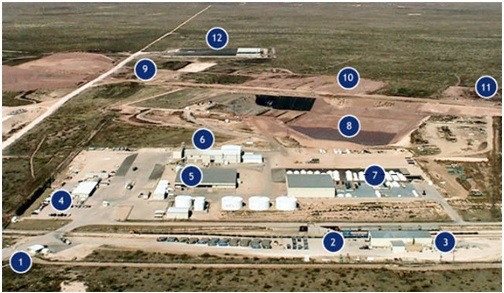What to do with nuclear waste is one of the big open questions with respect to nuclear power and nuclear weapons production. The United States spent over a decade preparing for a geological repository at Yucca Mountain in Nevada before the project was cancelled in 2009. Now the best estimate for a permanent nuclear waste repository is 2050. The repository was primarily intended for spent nuclear fuel which is quickly filling up all available temporary storage at nuclear reactor sites. There is a geological repository for nuclear waste generated by nuclear weapons production call the Waste Isolation Pilot Plant near Carlsbad, New Mexico. It had operated for fifteen years before an unexpected release of particles of plutonium and americium closed the repository. It may never reopen.
Texas legalized private nuclear waste dumps in 2003. The only existing such dump in Texas is the Waste Control Specialist's Facility (WCSF) low level nuclear waste dump in Andrews County. The dump can accept just about any type of nuclear waste. All radionuclides are welcome at the dump including plutonium which has a half life of hundreds of thousands of years. All components of nuclear reactors such as containment vessels, piping, sludge, and other residues can be stored there with the exception of spent nuclear fuel rods. One location was licensed to accept up to two million three hundred thousand cubic feet of waste. (11 on photo below) Another location was licensed to accept twenty six million cubic feet of radioactive waste from federal facilities. (10 on photo below) A third location has been designated for up to thirty thousand cubic feet of "by-product" waste which includes uranium mine tailings and yellow cake as well as equipment. (9 on photo below) The WCSF also has licenses that would permit it to process and store transuranic waste.
The Lone Star Sierra Club has been attempting to appealed to the Texas Commission on Environmental Quality (TCEQ) but been denied the right to a hearing to appeal these licenses on the grounds of public health threat. The TCEQ has been very friendly to industry and hostile to environmental groups. It is usually staffed by polluting industry alumni appointed by the governor. Texas is one of the most polluted states in the U.S. with some of the most lax regulation.
When the WIPP was closed, drums of waste from Los Alamos National Laboratory were shipped there for temporary storage. It turns out that some of these drums may be generating enough heat to explode because mistakes were made with absorbent additives at the laboratory. These drums are not stored in a facility that can monitor for anomalous heat production or confine explosions.
Now the TEQC has decided that it will allow the WCSF in Andrews County to accept depleted uranium from federal energy facilities. They are raising the allow amount from two million three hundred thousand cubic feet to nine million cubic feet. Environmentalists are complaining about this expansion of waste capacity. Depleted uranium waste can become more radioactive over time and poses a long term threat to public health. There are concerns about the local geology and underground water sources near the waste dump. Critics say that the amounts and types of waste being accepted at the site keep growing. No public comments were allowed when the TEQC voted to raise the storage limit.
There have been many explosions, fires and releases of toxic materials in Texas due to the industry friendly lax or non-existent regulation of industry. One day, release of hazardous radioactive materials may be added to the environmental devastation of Texas.
Waste Control Specialist's Facility:
